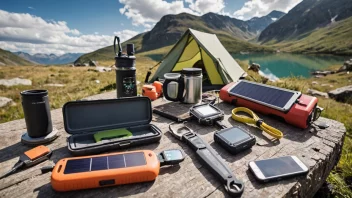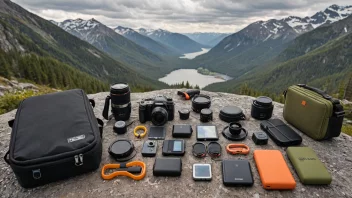Trail running is an exhilarating way to connect with nature, challenge your body, and enjoy the outdoors. However, the right gear can make all the difference in your experience, comfort, and performance. Choosing the right outdoor gear for trail running involves understanding your needs, the environment you'll be running in, and the technology available to enhance your experience. In this guide, we’ll delve into the essentials of trail running gear, covering everything from footwear to hydration solutions, ensuring you make informed choices that elevate your runs.
The Importance of Proper Footwear
Footwear is arguably the most critical piece of gear for any trail runner. The right shoes can protect your feet, provide stability, and enhance your overall performance. Here are key factors to consider:
1. Terrain Type
Trail shoes are designed for varying terrain, whether it’s rocky, muddy, or smooth. If you’re running on rocky paths, look for shoes with a more rigid sole and enhanced rock plate for protection. For muddy trails, opt for shoes with deeper lugs for improved traction.
2. Fit and Comfort
Ensure the shoes fit well, providing enough room for your toes without being too loose. Consider trying on shoes at the end of the day when your feet are slightly swollen to find the most comfortable fit.
3. Cushioning and Support
Cushioning is essential for absorbing impact, especially on harder surfaces. Choose a level of cushioning that matches your running style and comfort preference. Look for shoes with arch support if you have specific foot needs.
Choosing the Right Apparel
What you wear while trail running is just as important as your footwear. The right apparel can enhance comfort and performance while keeping you protected from the elements.
1. Fabrics Matter
Opt for moisture-wicking fabrics that keep sweat away from your skin. Look for materials like polyester or merino wool, which are breathable and quick-drying. Avoid cotton, as it retains moisture, leading to chafing and discomfort.
2. Layering Techniques
Depending on the weather, layering your clothing can help regulate body temperature. Start with a moisture-wicking base layer, add an insulating layer if it's cold, and finish with a waterproof shell if rain is in the forecast.
Hydration Solutions for Trail Running
Staying hydrated is crucial for performance and safety while trail running. Here are several hydration options to consider:
1. Hydration Packs
Hydration packs are excellent for longer runs, allowing you to carry water and essential gear without bulky bottles. Look for packs with adjustable straps for a comfortable fit and enough storage for snacks and emergency supplies.
2. Handheld Water Bottles
If you prefer a more minimalist approach, handheld water bottles or running belts can be a great choice. Ensure the bottle is lightweight and easy to grip, with a nozzle that allows for quick sips on the go.
3. Electrolyte Supplements
For longer runs, consider bringing electrolyte supplements or drinks to maintain hydration and energy levels. These can help prevent cramping and fatigue, keeping you energized throughout your run.
Navigation Tools and Technology
As a trail runner, navigating unfamiliar paths can be challenging. Utilizing technology can enhance your safety and experience:
1. GPS Watches
GPS watches provide real-time data on distance, pace, and elevation. Look for watches with trail-specific features, such as route tracking and heart rate monitoring.
2. Mobile Apps
Smartphone apps like Strava or AllTrails can help you find new trails, track your performance, and connect with other runners. Ensure you download maps before heading out, as cell service may be limited in remote areas.
Additional Gear for Safety and Comfort
While the essentials are crucial, additional gear can enhance your trail running experience:
1. First Aid Kit
Always carry a small first aid kit that includes band-aids, antiseptic wipes, and blister treatment. Being prepared for minor injuries can keep you safe during your run.
2. Sunscreen and Bug Spray
Protect your skin from the sun and bug bites with travel-sized sunscreen and insect repellent. Look for formulas that are sweat-resistant to ensure effectiveness during your run.
3. Trail Running Poles
If you’re tackling steep hills or uneven terrain, consider using trail running poles for added stability. They can help reduce strain on your knees and improve your balance.
Practice and Preparation
Before hitting the trails, proper preparation is essential. Here are some tips to get you ready:
1. Start Slow
If you’re new to trail running, begin with shorter distances and gradually increase your mileage. Familiarize yourself with different terrains to build confidence.
2. Plan Your Route
Research trails beforehand, considering difficulty and your fitness level. Always inform someone about your route and estimated return time for added safety.
3. Practice Nutrition
Experiment with nutrition during training runs to find what works best for you. Bringing snacks like energy gels, bars, or fruit can provide the necessary fuel for longer outings.
Conclusion
Selecting the right outdoor gear for trail running is a blend of personal preference, understanding your unique needs, and being aware of your environment. Invest time in finding the perfect footwear, apparel, hydration solutions, and navigation tools to enhance your trail running experience. Remember, preparation is key; the more prepared you are, the more enjoyable your runs will be. So lace up your shoes, pack your gear, and hit the trails with confidence!






